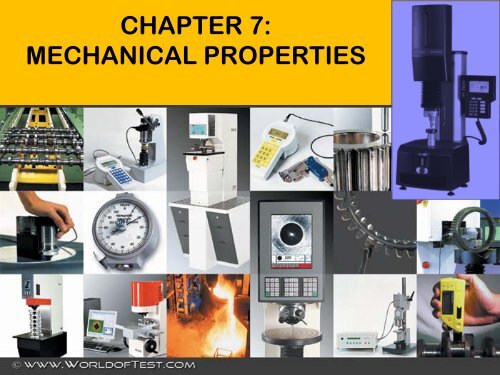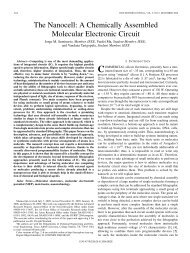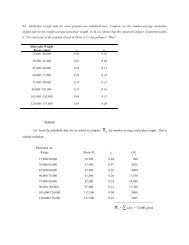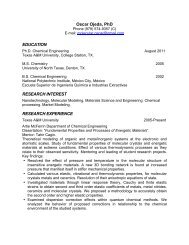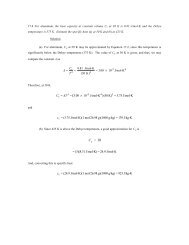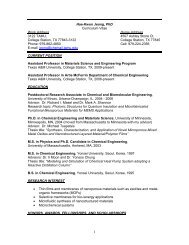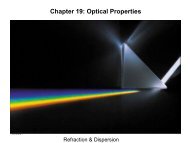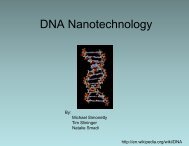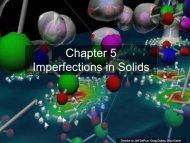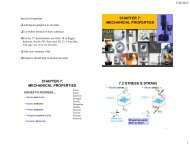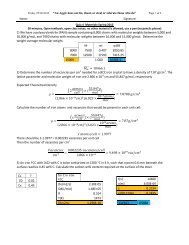CHAPTER 6: MECHANICAL PROPERTIES
CHAPTER 6: MECHANICAL PROPERTIES
CHAPTER 6: MECHANICAL PROPERTIES
Create successful ePaper yourself
Turn your PDF publications into a flip-book with our unique Google optimized e-Paper software.
<strong>CHAPTER</strong> 7:<strong>MECHANICAL</strong> <strong>PROPERTIES</strong>ISSUES TO ADDRESS...• Stress and strain• Elastic behavior• Plastic behavior• Toughness and ductility• Ceramic MaterialsStressStrainElasticityStrengthTensileElongationDuctileFractureTensionFlexuralPlasticity
Stress (σ) for tension andcompressionTensile loadCompressive loadσ = F A oStrain (ε) for tension andcompressionShear stressτ = F sAoShear strainγ = tan θTorsional deformationangle of twist, φ
7.2 COMMON STATES OF STRESS• Simple tension: cableσ = F A o• Simple shear: drive shaftSki lift (photo courtesy P.M. Anderson)τ = F sAoNote: τ = M/A c5
OTHER COMMON STRESS STATES• Simple compression:A oCanyon Bridge, Los Alamos, NM(photo courtesy P.M. Anderson)Balanced Rock, ArchesNational Park(photo courtesy P.M. Anderson)Note: compressivestructure member(σ < 0 here).6
OTHER COMMON STRESS STATES• Bi-axial tension:• Hydrostatic compression:Pressurized tank(photo courtesyP.M. Anderson)σθ > 0Fish under water(photo courtesyP.M. Anderson)σz > 0σ < 0 h7
• Tensile strain:ENGINEERING STRAINδ/2• Lateral strain:• Shear strain:θ/2δ L /2w oδ/2δ L /2L oπ/2 - θγ = tan θStrain is alwaysdimensionless.π/2θ/28
7.2 STRESS-STRAIN TESTING• Typical tensile specimen• Typical tensiletest machineAdapted from Fig. 6.2,Callister 6e.gaugelength(portion of sample with=reduced cross section)• Other types of tests:--compression: brittlematerials (e.g., concrete)--torsion: cylindrical tubes,shafts.Adapted from Fig. 6.3, Callister 6e.(Fig. 6.3 is taken from H.W. Hayden,W.G. Moffatt, and J. Wulff, TheStructure and Properties ofMaterials, Vol. III, MechanicalBehavior, p. 2, John Wiley and Sons,New York, 1965.)9
Normal and shear stresses on an arbitrary planeStress is a function of the orientationOn plane p-p’ the stress is not pure tensileThere are two componentsTensile or normal stress σ’ (normal to the pp’ plane)Shear stress τ’ (parallel to the pp’ plane)
ELASTIC DEFORMATIONS7.3 Stress-strain behavior• Modulus of Elasticity, E:(also known as Young's modulus)• Hooke's Law:σ = E ε• Poisson's ratio, ν:metals: ν ~ 0.33ceramics: ~0.25polymers: ~0.40Units:E: [GPa] or [psi]ν: dimensionless10
<strong>PROPERTIES</strong> FROM BONDING: E• Elastic modulus, EElastic modulusF ∆LA = E o L oEnergy ~ curvature at roEnergyE is larger if Eo is larger.unstretched lengthr osmaller Elastic Modulusrlarger Elastic Modulus11
c07f08
c07tf01
7.4 ANESLATICITYAssumed:Time-independent elastic deformationApplied stress produces instantaneous elastic strainRemains constant while elasticity stress is appliedAt release of load, strain is recoveredIn real life:Time-dependent elastic strain component: AnelasticityTime-dependent microscopic and atomistic processesFor metals is smallSignificant for polymeric materials: Viscoelastic behavior
7.5 ELASTIC <strong>PROPERTIES</strong> OF MATERIALSPoisson’s ratioν = -ε x /ε z = -ε y /ε zFor isotropic materialsG =E2(1+ ν)
E(GPa)10 9 Pa120010008006004002001008060402010864210.80.60.4MetalsAlloysYOUNG’S MODULI:COMPARISONGraphiteCeramicsSemicondDiamondSi carbideTungsten Al oxideMolybdenum Si nitrideSteel, NiTantalum Platinum Si crystalCu alloys Zinc, TiSilver, GoldAluminum Glass-sodaMagnesium,TinConcreteGraphitePolymersPolyesterPETPSPCPPHDPEPTFEComposites/fibersCarbon fibers onlyCFRE(|| fibers)*Aramid fibers onlyAFRE(|| fibers)*Glass fibers onlyGFRE(|| fibers)*GFRE*CFRE*GFRE( fibers)*CFRE( fibers)*AFRE( fibers)*Epoxy onlyWood( grain)Based on data in Table B2,Callister 6e.Composite data based onreinforced epoxy with 60 vol%of alignedcarbon (CFRE),aramid (AFRE), orglass (GFRE)fibers.0.2LDPE13
Assigment 1 Add figures/graphics to all slides Use bullets instead of shortsentences Font size 10, 12, 14 are fine. Youmay use 16 or 18 for titles Add your summary slide– shouldcontain graphics of your ownGraphics should explainAssignment 2Next Tuesday class is movedto Thursday 7-8:15 PM(room TBA)
II. <strong>MECHANICAL</strong> BEHAVIOR—METALS
II. ELASTIC DEFORMATION1. Initial 2. Small load 3. Unloadbondsstretchδreturn toinitialFElastic means reversible!2
II. PLASTIC (PERMANENT) DEFORMATION(at lower temperatures, T < T melt /3)• Simple tension test:15
II. PLASTIC DEFORMATION (METALS)1. Initial 2. Small load 3. UnloadFPlastic means permanent!linearelasticδplasticlinearelasticδ3
• YIELD STRENGTH, σ yStress at which noticeable plastic deformation hasoccurred.when ε p = 0.002tensile stress, σσy7.6 Tensile propertiesεp = 0.002engineering strain, ε16
7.6 YIELD STRENGTH: COMPARISONσy(ceramics)>>σy(metals)>> σy(polymers)Room T valuesBased on data in Table B4,Callister 6e.a = annealedhr = hot rolledag = agedcd = cold drawncw = cold workedqt = quenched & tempered17
7.6 TENSILE STRENGTH, TSMaximum possible engineering stress in tensionAdapted from Fig. 6.11,Callister 6e.• Metals: occurs when noticeable necking starts.• Ceramics: occurs when crack propagation starts.• Polymers: occurs when polymer backbones arealigned and about to break.18
7.6 TENSILE STRENGTH:COMPARISONTS(ceram)~TS(met)~ TS(comp)>> TS(poly)Room T valuesBased on data in Table B4,Callister 6e.a = annealedhr = hot rolledag = agedcd = cold drawncw = cold workedqt = quenched & temperedAFRE, GFRE, & CFRE =aramid, glass, & carbonfiber-reinforced epoxycomposites, with 60 vol%fibers.19
7.6 DUCTILITY, %ELDegree of plastic deformation at fractureBrittle, when very little plastic deformation• Plastic tensile strain at failure:%EL = L f − L oL ox100Adapted from Fig. 6.13,Callister 6e.ductility as percent reductionin area%AR = A o − A fA ox100• Note: %AR and %EL are often comparable.--Reason: crystal slip does not change material volume.--%AR > %EL possible if internal voids form in neck.20
c07tf02
Stress-strain of iron at several temperaturesc07f14
RESILIENCECapacity to absorb energy when deformed elastically and then uponunloadign, to have this energy recoveredModulus of ResilienceU r= y σdε∫ε0For a linear elastic region:Ur1= σyεy2
7.6 TOUGHNESS• Ability to absorb energy up to fractureEngineeringtensilestress, σsmaller toughness (ceramics)larger toughness(metals, PMCs)smaller toughnessunreinforcedpolymersEngineering tensile strain, εUsually ductile materials are tougher than brittle onesAreas below the curves21
7.7 True stress & strainDecline in stress necessary to continue deformation past MLooks like metal become weakerActually, it is increasing in strengthCross sectional area decreases rapidly within the neck regionReduction in the load-bearing capacity of the specimenStress should consider deformation
7.7 True stress & strainHARDENING: An increase in σ y due to plastic deformation.• Curve fit to the stress-strain response:σ = KεnT Tn = hardening exponentn = 0.15 (some steels)n = 0.5 (some copper)22
c07tf04
7.8 Elastic Recovery After Plastic Deformation
7.9 Compressive, Shear, andTorsional DeformationSimilar to tensile counterpartNo maximum for compressionNecking does not occurMode of fracture different from that oftension
III. <strong>MECHANICAL</strong> BEHAVIOR—CERAMICSLimited applicability, catastrophic fracture in a brittlemanner, little energy absorption7.10 FLEXURAL STRENGTHTensile tests are difficultdifficult to prepare geometryeasy to fractureceramics fail at 0.1% strainbending stressrod specimen is usedthree of four point loading techniqueflexure test
7.10 MEASURING STRENGTH• Flexural strength= modulus of rupture= fracture strength = bend strengthσ fs=σ =fs32bdF fF fLπ R3L2• Type values:Material σfs(MPa) E(GPa)Si nitrideSi carbideAl oxideglass (soda)700-1000550-860275-55069Data from Table 12.5, Callister 6e.30043039069
7.11 Elastic Behavior (forceramics)Similar to tensile test for metalsLinear stress-strainModuli of elasticity forceramics are slightly higherthan for metalsNo plastic deformation priorto fracture
7.12 INFLUENCE OF POROSITY ON THE<strong>MECHANICAL</strong> <strong>PROPERTIES</strong> OF CERAMICSPowder as precursorAluminum oxideE = Eo(1 – 1.9P + 0.9P 2 )Compaction to desire shapePores or voids eliminationincompleteResidual porosity remainsDeleterious influence onelasticity and strengthVolume fraction porosity PEo = modulus of elasticity ofthe non porous material-Pores reduce the area-Pores are stress concentrators-tensile stress doubles in anisolated spherical poreAluminum oxideσ fs = σ o e -nP
IV <strong>MECHANICAL</strong> BEHAVIOR—POLYMERS7.13 STRESS—STRAIN BEHAVIORStress-strain curvesadapted from Fig.15.1, Callister 6e.Inset figures alongelastomer curve(green) adapted fromFig. 15.14, Callister6e. (Fig. 15.14 is fromZ.D. Jastrzebski, TheNature and Propertiesof EngineeringMaterials, 3rd ed.,John Wiley and Sons,1987.)• Compare to responses of other polymers:--brittle response (aligned, cross linked & networked case)--plastic response (semi-crystalline case)
7.13 T & STRAIN RATE: THERMOPLASTICS• Decreasing T...--increases E--increases TS--decreases %EL• Increasingstrain rate...--same effectsas decreasing T.26
7.14 Macroscopic DeformationSemicrystaline polymerc07f25
7.15 Viscoelasticity DeformationAmorphous polymer:Glass at low TViscous liquid at higher TSmall deformation at low T may be elasticHooke’s lawRubbery solid at intermediate TA combination of glass and viscous/liquidViscoelasticityElastic deformation is instantaneousUpon release, deformation is totally recovered
7.15 Viscoelasticity DeformationLoadTotally elasticViscousViscoelasticc07f26
Relaxation Modulus for viscoelasticpolymers:Er( t)=σ ( t)εoAmorphous polystyreneA viscoelastic polymer
Polystyrene configurationsAlmost totally crystalline isotacticLightly crosslinked atacticViscoelastic creepCreep modulus E c (t)Ec( t)=σoε ( t)amorphous
V. Hardness & Other Mechanical Property Considerations7.16 HardnessMeasure of material resistance to localized plastic deformationEarly tests: Mohs scale 1 for talc and 10 for diamondDepth or size of an indentationTests:Mohs HardnessRockwell HardnessBrinell HardnessKnoop & Vickers Microindentation Hardness
c07tf05
c07tf06a
c07tf06b
Hardness Conversion
Correlation between Hardness and Tensile StrengthTensile strength and Hardnessmeasure metal resistance to plasticdeformationFor example:TS(Mpa) = 3.45 × HBorTS(psi) = 500 × HB
7.17 Hardness of Ceramic Materialsc07tf07
7.18 Tear Strength & Hardness of PolymersThin films in packagingTear Strength: Energy required to tear apart a cut specimen of astandard geometry
VI. Property Variability and Design/Safety Factors7.19 Variability of Material Properties: Average andstandard deviation
7.20 DESIGN/SAFETY FACTORS• Design uncertainties mean we do not push the limit.• Factor of safety, Nσ working= σ yNOften N isbetween1.2 and 4• Ex: Calculate a diameter, d, to ensure that yield doesnot occur in the 1045 carbon steel rod below. Use afactor of safety of 5.σ working220,000N⎛π d 2 ⎞ 5⎜ / 4⎟⎝ ⎠= σ yNd = 47.5 mm29
SUMMARY• Stress and strain: These are size-independentmeasures of load and displacement, respectively.• Elastic behavior: This reversible behavior oftenshows a linear relation between stress and strain.To minimize deformation, select a material with alarge elastic modulus (E or G).• Plastic behavior: This permanent deformationbehavior occurs when the tensile (or compressive)uniaxial stress reaches σy.• Toughness: The energy needed to break a unitvolume of material.• Ductility: The plastic strain at failure.30


